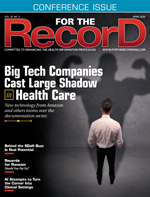April  2020
2020
HIT Happenings: Data Capture Enables Digital Transformation
By Bruce Scharf
For The Record
Vol. 32 No. 3 P. 5
Data capture technology such as barcode scanning is fueling today’s digital transformation wave. It has quickly evolved from being an enabler of piecemeal benchmarks in efficiency to the engine that is driving fundamental leaps in innovation.
To be successful in the move from clipboards and file cabinets to touchscreen tablets and cloud infrastructure, hospitals and clinics need a combination of hardware and software that delivers efficiency while securely delivering the ability to capture, aggregate, and analyze data.
Data Capture Is the First Line of Digital Transformation
Quality of care, which is the lifeblood of any health care organization, represents a combination of competency and efficiency. Advancements in data capture, primarily the use of barcode scanning solutions, are proving helpful at physical points such as incoming and outgoing inventory and bedside patient care. These uses of scanning solutions are helping remove roadblocks and reduce errors.
Data capture requires absolute integration with EHRs. It is difficult to picture the future of health care without comprehensive EHRs. With EHRs, every health care provider, including primary care physicians, specialists, nurses, technicians, and other clinicians, can access the same accurate, up-to-date patient information.
Data capture/collection technologies are the physical link between the patient and the EHR. This link has brought a number of benefits to health care systems in recent years. In a study published by the New England Journal of Medicine, observers noted a 41.4% relative reduction in nontiming errors in medication administration on units that used barcode reading technology. In addition, the rate of potential adverse drug events fell by 50.8% and the rate of timing errors in medication administration fell by 27.3%. It is also interesting to note that in this study, transcription errors were completely eliminated on units that used barcode scanners.
Seeing and Reading All the Data
The truth is, barcodes are everywhere and come in more types and symbologies, shapes, and sizes than most people realize. This variety is due in part to individual institutional policies as well as legislation such as the Drug Supply Chain Security Act and subsequent serialization requirements.
Barcodes can be found on every bottle of medication, various types of specimen samples, blood transfusion equipment, surgical instruments, and even patients. They come in several different codes and symbologies, including traditional barcodes, 2D codes such as quick response codes, and others.
This variety is coupled with the fact that an item such as a blood bag may have half a dozen or more different barcodes on a single bag. Being able to quickly scan any barcode, regardless of type, the surface it is on, or even what condition it is in, is essential. This enables doctors, nurses, and others involved in patient care to be more efficient, reduce risk, and minimize bedside errors. Lives depend on the scanning technology being able to read and enter data correctly.
Recent advancements in technology expand the reading range of scanners and provide greater accuracy. For example, dual-field optics provide two unique fields of view in one device: a high-density field and a wide-angle field. This reduces scanner reading issues and allows the device to collect data even from barcodes that are hard to read, damaged, or placed on curved or shiny surfaces.
This zero-miss ability gives users a solution that will intuitively know which field should be used to read either a wide or a small, dense barcode. Having these two optical fields in the same reader allows for greater versatility and accuracy.
Enhancing the Management of Patient Data
Barcode scanning has evolved significantly over the past 20 years. Advancements in algorithms, applications, and software have reduced administration bottlenecks and significantly helped mitigate costly medical errors by ensuring caregivers record and obtain accurate patient data. However, software is only half the solution.
Barcode scanning devices themselves have also seen tremendous evolution in recent years. One of the unintended consequences of digital transformation and EHR systems is that as more comprehensive and accurate records were being kept, hospitals found themselves identifying, evaluating, and documenting risk factors for hospital-borne infections. These data have helped identify areas that need more robust infection control strategies to address threats, including staphylococcus aureus as well as MRSA and Clostridium difficile, types of bacteria that are resistant to most antibiotics.
The scanning devices that are in the hands of physicians and nurses are some of the most-used items in a hospital. As such, they have to be physically able to handle the chemically rigorous processes in a clean hospital room—the front line of the bacteria battleground.
In the early years of digital transformation, the metals and plastics used were not compatible with the harsh chemicals employed to clean the rooms. Equipment of all types was being corroded, dissolved, and destroyed. After several years and significant research and development investment, new materials and approaches were introduced to curb this challenge. Today, health care–specific barcode readers are made of disinfectant-ready (resistant) plastics, disinfectant-treated plastic (eg, silver nitrate–impregnated plastics), and medical-grade plastics that can handle the stringent routine cleaning.
Enabling a true digital transformation requires a marriage of tough hardware and smart software. Barcode scanning for data capture has become a core component of the digital transformation movement by connecting the physical and digital worlds together.
— Bruce Scharf is vice president at Code Corporation. He has more than 20 years of experience in the data capture industry and has secured numerous patents. In his current role, he leads engineers, scientists, and technicians occupied in software, hardware, electrical, mechanical, and optical design.



